Rose in a pot: how to care for a flower at home?
For any home flower collector, growing roses, it's a challenge. Because it is quite difficult to make this wonderful flower feel good. As beautiful as this queen of flowers, she is also capricious. But with due perseverance and adherence to a clear schedule of palace ceremonies, the rose usually remains satisfied and pleases with the flowering of a delicate color.
Content:
- Description of the home rose
- Required conditions for growing a flower
- Soil and container for a flower
- Watering and feeding
- How and when to prune a rose?
- Transplant terms and rules
- Diseases and pests of the rose
Description of the home rose
Of course, for lovers of garden roses there is a wider choice than for those who decided to settle such a beauty at home. But this flower from the Rosaceae family grows, although it is small, only 50 cm, but it pleases with a long and prolonged flowering.
But it is also pleasing that several types stand out among domestic roses:
- climbing
- standard
- groundcover
But the bulk of domestic representatives is still presented in bush form. These roses usually have leaves:
- with carved edge
- either in the form of a pointed plate
- either small and matte
The variety of inflorescences varies from very small to larger and more voluminous. The color differs in many shades, even in the general color palette:
- yellow from pale lemon to amber
- pink from pale lilac to bright fuchsia
- scarlet from red brocade to shiny velvet terracotta color
It is important to note that a rose will take root at home only if it is grown from a cuttings, the grafted rose will not be able to survive. Therefore, when buying a flower, you need to inquire about the growing method. Although the home rose can bloom all year round, some varieties still require rest. But experienced florists are advised to send all varieties on vacation, even if forced.
Required conditions for growing a flower
In order for an overseas beauty to constantly delight her with her appearance, it is necessary to provide her with the appropriate conditions and care:
- Indoor air temperature. Starting from the last month of winter, namely from February, the indoor rose enters the active growth phase, and from that time it is necessary to increase the temperature in the room where the rose is located. The temperature for comfortable flowering should not be lower than + 22 C. But during the dormant period, it is better to keep the flower at a low temperature from + 5 to + 8 C. This will give an opportunity to rest and gain new strength for the plant.
- Indoor air humidity. When rose flower is contained in the room, then the dry air of the heated home can harm it. Therefore, it must be sprayed. The water should be filtered and warm. Biofungicides or granulated plant sugar can be added periodically. It is good for a plant to locate an electric evaporator nearby or spread pebbles near a flower pot and fill it with water.
- Lighting... Good lighting is important for keeping roses. They are very light-requiring and without active light filling they start to get sick. Therefore, in the winter months it is necessary to supplement them. phytolamps, and in the summer to leave outdoors for a long time.
Soil and container for a flower
Important points when growing a plant from the Rosaceae family is the presence of good soil and capacity for the flower to live. For a rose, the soil should be loose and rich in organic.
If the soil composition was purchased in a store, then it should be supplemented with deciduous humus and rotted manure in equal parts.
The recipe for self-preparation of the mixture:
- deciduous humus - 1 part
- turf land - 1 part
- garden land - part 1
- sand - 1 part
- high peat - 1 part
- sphagnum moss or hydrogel
The container should have a good drainage layer and a sump for draining excess water. Rose does not like to keep her feet cold and damp, so the excess liquid should be removed two hours after watering. The edge of the pot should be equal to the crown of the flower, this will serve as a sign that the ideal volume has been found. When transplanting, you cannot dramatically increase the size of the pot.
Watering and feeding
The conditions for the well-being of a blooming rose are systematic watering and regular feeding during the active phase of rose growth:
- Watering... For the southern beauty, regularity of watering is very important. The liquid should be slightly warm, and must be filtered. You should especially carefully monitor the water temperature and the frequency of watering during the flowering period. As soon as buds begin to form on the bushes, then watering procedures should be increased in frequency. And as soon as young sticky greens appear, even more water is needed. But with the onset of the sleep and rest phase, watering is reduced. Attention! Do not allow waterlogging or drying out of the earthen coma of the rose. This has an extremely negative effect on her condition.
- Loosening after watering. An important procedure. First, it opens up air access to the roots. Secondly, it allows you to understand whether additional moisture is required or not.
- Top dressing. As soon as the awakening phase begins, the beauty will require a full-fledged diet in nutrition. Balanced food will allow the rose to grow actively, decorate the room with long flowering and gain strength for a long active phase. Top dressing is required to be applied approximately once every 10 days. Both liquid formulations and dry mixtures are suitable. It is only important to properly distribute and dose the necessary bush mineral and organic matter. An infusion of cow or goat manure will be of particular benefit to the plant. Only cow dung should be overheated for about a year before application, while goat manure can be used fresh. Compositions with phosphorus and potassium will not be superfluous. But it is worth noting that with the approach of autumn, feeding should be reduced, and from October it should be stopped altogether in order to allow the plant to calmly digest and assimilate all the useful summer procedures and vitamins.
How and when to prune a rose?
Pruning a rose is not only giving the flower crown a graceful shape, but also treating the plant in order to avoid the formation of pest shelters among old and dead branches.
Types of trimming:
- sanitary pruning - helps to get rid of old, weak and dead branches
- rejuvenating pruning - done once every few years and its purpose is to free the bush from too thick "hair"
- formative pruning - helps to maintain the decorative appearance of the rose
- restraining pruning - allows you to keep the bush at the desired height
- stimulating pruning - done before flowering, so that more nutrition gets to the buds
Pruning is best done after the roses begin to wake up, but before budding. Summer August pruning is required only for intensely flowering bushes. After the procedure, it is best to keep the rose in a room with a temperature of 10 C, this will allow the flower to wake up slowly and form new branches in place of the old ones.
If the rose has just "arrived" in a new home, then it is necessary to give it time to adapt.For several weeks, the flower must get used to the new conditions and only after that it is worth starting to manipulate the pruning. In principle, the pruning process is not difficult, but if in doubt, then you can refer the flower to florists, and they will show you how to correctly cut and remove unnecessary material.
Transplant terms and rules
This point is worth focusing on:
- If a indoor rose purchased in a store, then before replanting it, the roots should be dipped into a solution of biofungicide, however, this should also be done if the rose is transferred from the garden to the house.
- The rose is taken out completely with an earthen lump, and in this state it is placed in a biofungicide solution.
- The rose requires good drainage in the pot.
- In order to avoid the appearance of air pockets, the rose should either be shed well after transplanting, or it should be carefully stitched with a wooden stick along the edges (stitching means pushing the earth inside along the edge of the coma).
- In places of the formed voids, it is necessary to fill up the earth.
- The first week after transplanting, the soil may settle and compact, so that the roots do not bare, you should carefully monitor the condition of the earth cover and fill up the soil to the required amount, if necessary.
- The transplanted plant is placed in the shade for a day, and the water is no longer topped up and the plant is not sprayed.
- The next day, it is worth taking the plant to its habitat for a couple of hours, and then returning it to the shade.
- So the rose should get used to the new place for two days, and then finally get over.
Annual transplant:
- It is better to replant in early spring.
- The pot should not be much larger than it used to be.
- The land must be fresh.
Diseases and pests of the rose
It is sad when a pet gets sick or is attacked by pests. To avoid the death of the enemy plant, you need to know by sight and recognize in time:
- Spotting, can be seen by the formation of dark spots on the foliage. It is impossible to ignore the disease, it is easier to immediately throw out the rose. Preparations containing sulfur or copper help. Yellow roses are especially susceptible.
- Powdery mildew... White bloom on the leaves from the outside signals that trouble has occurred. The damaged areas need to be urgently removed and burned or thrown into the garbage chute. Next, the pot and the rose are treated with Fundazol.
- Bacterial cancer. It is a viral and most devastating disease for rose bushes. The affected areas must not only be removed, but also disinfected. Cut off shoots are dipped in a solution of copper sulfate for a couple of minutes. Infected parts should not be thrown into the soil, the disease is dangerous and grows rapidly.
- Spider mite. This pest appears if the air in the room is too dry.
Lush rose bushes are absolutely a dream come true, but in order for the aromas of roses to float at home, you need to try a little and give the Queen the honors she deserves.
More information can be found in the video:



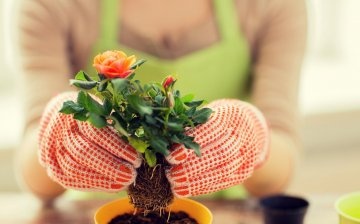
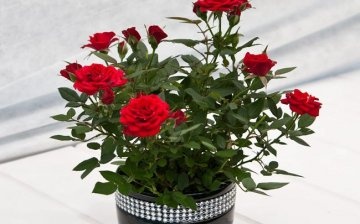
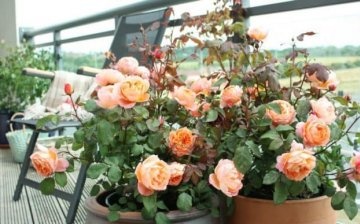


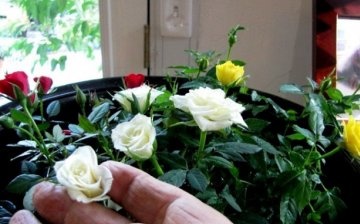










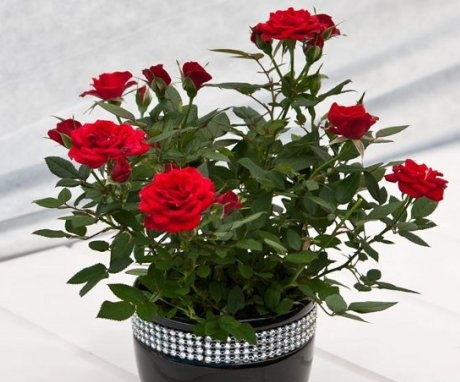

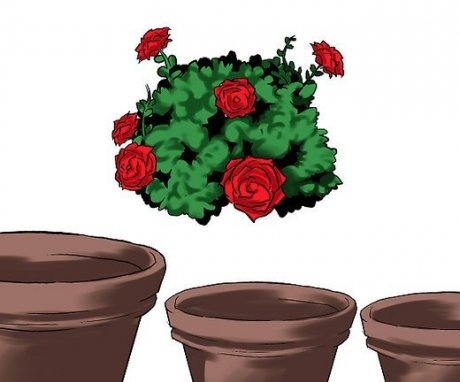

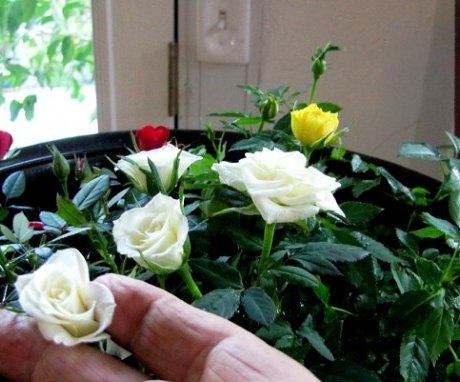
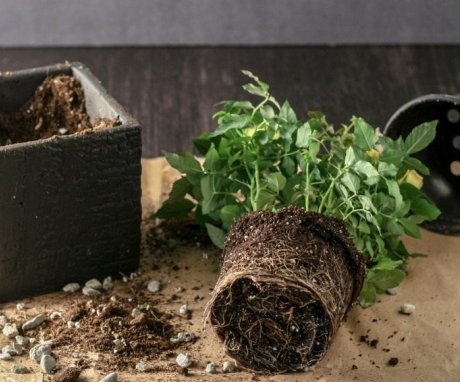
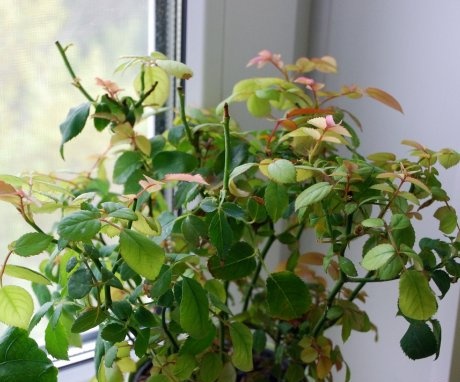
Previous attempts to grow a rose at home were unsuccessful for me. Perhaps it makes sense to buy a humidifier, as it’s probably a little dry in the room, especially in winter, when the heating is on. I will definitely try again, now following the advice from the article.
I have been growing roses in pots for 3 years. Before buying, I always carefully examine the flower to make it look healthy and beautiful in appearance. Then I bring the rose home and do not transplant it yet. I am engaged in transplanting only when all the buds from bloom or lose. And in general, the flower should not be transplanted right away, even if there are no flowers. Because the rose will already have a new place, and so it takes time to get used to it. The rose should be placed in a lighted place, but at the same time avoid the sun's rays. If the house is hot, you need to constantly spray the plants, and it is better to purchase a humidifier.Of course, do not forget to feed the flower, and then it will delight you with its green foliage and beautiful flowering. In general, that's all I wanted to say.
Quite a picky plant for indoor cultivation, right, a whole care technology. Maybe a rose in a pot can be grown from a rooted cuttings, because it will not grow in the open field due to low frost resistance?